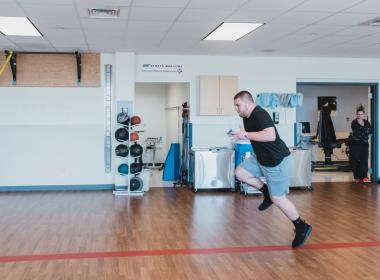Article
Community Benefit Report: Supporting Children and Families
As the only freestanding children’s hospital in our state, Connecticut Children’s proudly continues to extend our impact in strengthening families so they are best positioned to promote their children’s health, development and well-being. Our best practices from the past year are

Article
Grow Committed: Zach’s Story
Imagine: You are a star football player walking onto the field for the first game of your senior year. It is Friday night, and the stands are packed. You’ve already racked up three all-conference and two all-state selections in your first three years of high school; you’ve been

Sickle Cell Patient with Fever Clinical Pathway
Patients with sickle cell disease (SCD) are at increased risk of severe bacterial infections, in large part due to reduced or absent splenic function. Repeated episodes of sickling and infarction lead to ‘autosplenectomy,’ often by age three years. Functionally asplenic patients
Diabetic Ketoacidosis Clinical Pathway
Diabetic Ketoacidosis (DKA) is a potentially fatal metabolic complication of uncontrolled diabetes mellitus. DKA consists of the biochemical triad of hyperglycemia, ketonemia and metabolic acidosis, resulting from absolute or relative insulin deficiency in the presence of an
Pediatric Cardio-Oncology Acute Cardiotoxicity Primary and Secondary Prevention Strategies Clinical Pathway
Cardio-oncology is an emerging field. Childhood cancer survivors receive numerous cancer treatments that are cardiotoxic. Among the nearly 500,000 long-term childhood cancer survivors in the United States, more than half were treated with cardiotoxic cancer therapy, which results
Ketogenic Diet and Modified Ketogenic Diet Clinical Pathway
Ketogenic and modified ketogenic diets are high fat, low carbohydrate diets used as evidence-based treatment for intractable seizures. These pathways were developed to aid with initiation of these diets for established neurology patients at Connecticut Children’s. Initiation of
Kids Connect TV Studio
With support from our friends at Dunkin Joy in Childhood Foundation, Kids Connect TV Studio is on the air at Connecticut Children's! Kids Connect TV is a dedicated channel designed to engage hospitalized patients and their families through an interactive hospital broadcast. The
Service/Program
Pediatric Tracheostomy
There are many reasons that a child may need a tracheostomy, a surgical procedure used to create an opening through the neck into the trachea (windpipe). For example, when a child’s airway is permanently blocked, cannot be cleared of secretions or must be supported by a
Burn Clinical Pathway
Connecticut Children’s cares for patients with mild to moderately burns. Burn injury can vary in severity from superficial to partial thickness to full thickness. Connecticut Children’s has not had a standardized approach to care for these children in the past. A standardized
Specialty
Dentistry
If your child needs a dental specialist, you’ve come to the right place. The pediatric dentists and oral and maxillofacial surgeons who practice at Connecticut Children’s specialize in treating the full spectrum of dental needs for children of all ages. From impacted wisdom teeth
Asthma (Emergency Department and Inpatient) Clinical Pathway
In the United States, asthma affects 7 million children under 18 years. In 2010, 58.3% of children with asthma had at least one asthma attack in the previous twelve months. Nearly 20% of children diagnosed with asthma went to an ED for care in 2009. Asthma is the third¬ ranking
Ischemic Stroke Evaluation and Management Clinical Pathway
Pathway Background Stroke is a neurological injury caused by the occlusion or rupture of cerebral blood vessels. Strokes can be ischemic, hemorrhagic, or both. Ischemic stroke is most frequently caused by arterial occlusion, but may be caused by venous occlusion of cerebral veins
Tonsillectomy and Adenoidectomy: Perioperative Care Clinical Pathway
Tonsillectomy and adenoidectomy is a common procedure with greater than 500,000 performed annually in the United States. However, there is variability in peri-operative and post-operative care for these patients. This can lead to confusion and dissatisfaction for patients